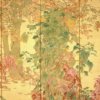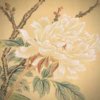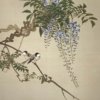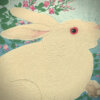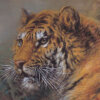Utsumi Kichidō: Nanga Painter of the Meiji and Taishō eras Who Traveled to China.
Autumn Grass Cold Glaze
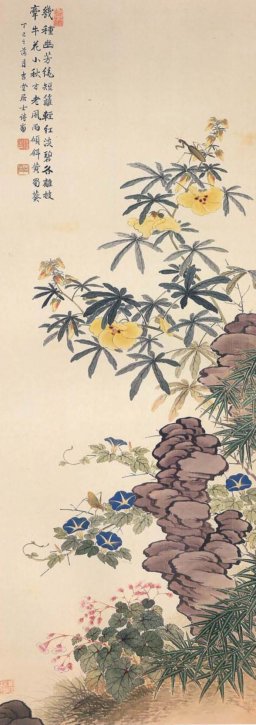
Utsumi Kichidō was born in Fukui Prefecture in 1850. His father was a pupil of Okamoto Toyohiko, so he went to Kyōto to study under Shiokawa Bunrin, who was also a pupil of Toyohiko. In 1877, he traveled to China and returned to Japan in 1882. After returning to Japan, he was active as a Nanga painter and played an important role in the establishment of the Kyōto Youth Painting Study Group, the Kōso Association, and the Japan Nanga Institute.
In this painting, there is a mixture of aspects of Kichidō as a Nanga artist and the Shijō School. From the compositional point of view, from the top to the bottom of the painting, there are yellowish hollyhock, morning glory, and begonia evansiana are painted. Strange stones and bamboos are placed to connect each of them, making the painting the Nanga style expression. The artist’s taste is unique among Nanga artists in that he placed a praying mantis on a yellowish hollyhock and a grasshopper on a morning glory. From there, it can be seen that the photographic taste of the Shijō School, which has been passed down since Matsumura Goshun, remains strong.
Wild Goose in Reeds Painting

Utsumi Kichidō became a pupil of Shiokawa Bunrin, a painter of the Shijō School, and learned the technique of “sketching”. Bunrin was a unique painter among the Shijō School, who had a strong brushing style, was free-spirited, and seemed to orient toward Chinese-style painting. It is not surprising that Kichidō inherited this tendency from Bunrin, and after Bunrin’s death, he went to China and became independent as a Nanga painter.
This painting also shows this tendency, and rather than focusing on sketching, Kichidō is more interested in expressing the atmosphere and sentiment. The original work of this “Wild Geese Painting” by Kichidō was painted by Hara Zaichū during the Kansei period (1789-1801), and it can be said that it was restored by Kichidō. Therefore, we can see vestiges of the techniques of the Hara School in the expression of the reeds, the flying geese, and the rocks. In addition, the stylized expression of the water’s edge and the waves of the flying geese can be said to have followed the techniques of the Hara School. However, the expression of the transition from the lush green of the reeds to the withered reeds shows ambiguous tastes, which seems to express Kichidō’s feelings.

